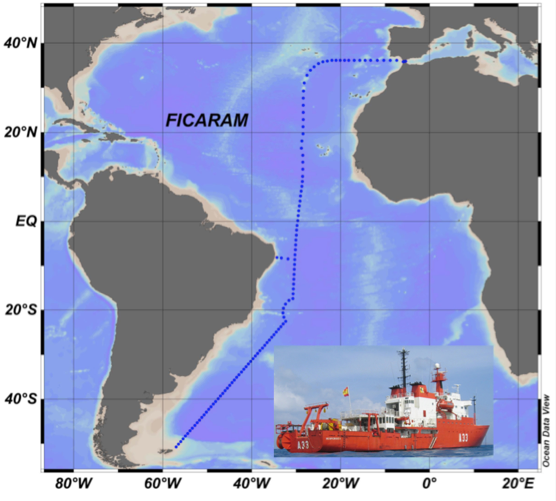04. FICARAM Cruise

The FICARAM-15 cruise is the fifteenth repeat of section conducted in 1994. This section is part of the international program GOSHIP (http://www.go-ship.org/CruisePlans.html) to develop a globally coordinated network of sustained hydrographic sections as part of the global ocean/climate observing system. The FICARAM cruise was carried out on board the R/V HESPERIDES (20 March 20 to 22 May 2013), from Punta Arenas (Chile) to Cartagena (Spain).
The objective of the FICARAM-15 cruise is to investigate the temporal evolution of anthropogenic carbon and evaluate the CO2 absorption capacity in the South Atlantic region, Equatorial zone, and the subtropical region of Azores-Gibraltar in the North Atlantic. This cruise is supported by CATARINA project funded by the Ministry of Economy and Competitiveness (CTM2010-17141), co-funded by FEDER funds, and is part of the European Union FP7 project CARBOCHANGE (http://carbochange.b.uib.no/). The objective of FICARAM-15 cruise is framed the CATARINA project conducted by the tasks I.2.1 (air-sea CO2 exchange) I.3 (ventilation of water masses), I.4.1 (zonal variability of N2O and CH4), I.4.2 (anthropogenic carbon storage), I.4.4 (saturation horizon of calcium carbonate along the section) and I.5.4 (evolution of the acidification rates).
Another component of FICARAM-15 cruise aims examine the biological and biogeochemical mechanisms that hinder total dissolved organic carbon (DOC) remineralisation in marine systems, taking a multidisciplinary perspective and applying many different approaches. This is the global objective of the Spanish project DOREMI (CTM2012-34294) that joins this FICARAM-15 cruise.
The FICARAM-15 cruise was organized in two phases with a common sampling.
LEG 1: From Punta Arenas (Chile) to Recife (Brazil): 62 stations.
Chief Scientist: Aida F. Ríos, PI of CATARINA project
LEG 2: from Recife (Brazil) to Cartagena (Spain): 46 stations
Chief Scientist: Celia Marrasé, PI of DOREMI project
The Cruise report contains the sampling of all the variables at each station along section FICARAM, as well as the analysis of the biogeochemical variables and the preliminary results.






 Cruise report
Cruise report



